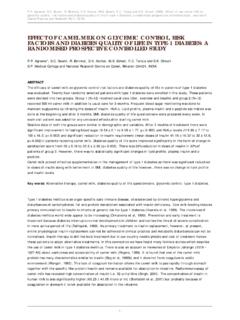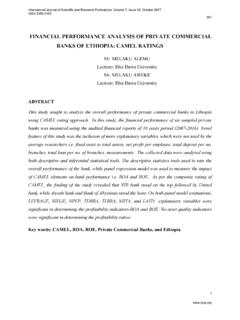Transcription of Importance of camel milk - An alternative dairy food
1 Patel et al. 2016/ J. Livestock Sci. 7: 19-25. Importance of camel milk - An alternative dairy food Patel1*, S. J. Patel2, N. R. Patel1 and Chaudhary3. 1. College of Veterinary Science and , AAU, Anand-388 001, 2 College of Veterinary Science and Animal Husbandry, JAU, Junagadh-362 001 3 College of dairy Science, AAU, Anand, INDIA. *. Corresponding author, E-mail: Journal of Livestock Science (ISSN online 2277-6214) 7:19-25. Received on 17/10/2015; Accepted on 26/12/2015. Abstract camel is known as Ship of the Desert . camel milk is different from cow milk in its chemical composition but it contains all essential nutrients as cow milk . Indian camels yield kg to 10 kg of milk per day. The taste of camel milk depends upon availability of plants for grazing.
2 The water content of camel milk fluctuates from 84 percent to 90 percent. camel keepers utilize milk either raw, boiled or for tea preparation. Various camel milk products were prepared and commercialized available viz., ice cream/ kulfi with different flavors, flavored milk , fermented milk , cheese, tea and coffee. The vitamin C levels are three times that of cow milk and one-and- a-half that of human milk . camel milk is used for treating dropsy, jaundice, spleen ailments, tuberculosis, asthma, anemia and piles. Keywords: milk ; milk composition; milk products; camel 19. Patel et al. 2016/ J. Livestock Sci. 7: 19-25. Introduction An important component of desert ecosystem from time immemorial which has been recognized as the Ship of the Desert is the camel .
3 Majority of the population of the desert depends upon this animal for the meat, milk , hides and also for transportation in the desert. The camel belongs to genus Camelus having two species: 1. Camelus dromedarius Dromedary or One humped camel - found in Africa, Arabia, Iran, Afghanistan and India. 2. Camelus bactrianus Bactrian or Two humped camel - found in Central Asia reaching up to Mongolia and Western parts of China. The females calve for the first time at the age of 4-5 years. They lactate for 8 18 months. The camels are milked twice a day. Lactation yields range from 2000 kg (Gohl, 1979) to 2700 3600 kg (Rao et al., 1970) under good feeding conditions and about 1360 kg when feed supplies are poor.
4 (Yasin and Wahid, 1957). Characteristics of camel milk camel milk is generally opaque white (Dihanyan, 1959; Heraskov, 1953; Yagil and Etzion, 1980). Normally it has a sweet and sharp taste, but sometimes it is salty (Rao et al., 1970). It is frothy when shaken slightly (Shalash, 1979). The changes in taste are caused by the type of fodder and the availability of drinking water. camel milk is somehow different from cow milk in its chemical composition but it contains all essential nutrients as cow milk (Elagamy, 1996). Unlike cow milk , it was found that camel milk can be preserved for a longer time at 30 C and most importantly the camel milk can be kept at 4 C for more than three months without any visible change (Yagil et al.)
5 , 1978). Indian camels yield kg to 10 kg of milk per day. The taste of camel milk depends upon availability of plants for grazing. camel milk can be preserved for 2-3 days at room temperature under field conditions. (Khedkar et al., 2002). Composition of camel 's milk The first milk , the colostrum, is white and slightly diluted as compared with the colostrum of cow (Yagil and Etzion, 1980). The specific gravity of camel milk is less than that of cow, sheep or buffalo milk (Shalash, 1979). The most important factor in camel milk is water content. Young camels , and especially the humans living in drought areas, are in need of fluid to maintain homeostasis and thermo-neutrality. The water content of camel milk fluctuates from 84.
6 Percent (Knoess, 1976) to 90 percent (Ohri and Joshi, 1961). Fat SNF Protein Lactose Ash Density % Water References % % % % % %. Ohri & Joshi, 1961. Khan & Appena, 1964. - Singh, 1962. - - Singh, 1962. - - Raghvendar et al., 2004. Fat The milk fat is also different from that of other animals. When left standing, fat is distributed as small globules throughout the milk (Yagil and Etzion, 1980). The ratio of fat to total solids average percent (Shalash, 1979). This is much lower than that of the buffalo, which is percent. These difference in milk fat necessitated saponification of camel milk in order to extract vitamin A and carotene (Khan and Appena, 1967). camel milk fat has a low Reichert value of (Dhingra, 1934).
7 The fatty acid composition of camel milk fat was found to be as follows (in weight percentage): Butyric acid Caproic acid Caprylic acid Capric acid Lauric acid Myristic acid Palmitic acid Stearic acid Oleic acid Linoleic acid 20. Patel et al. 2016/ J. Livestock Sci. 7: 19-25. Compared to cow, buffalo and ewe milk fat, camel milk fat contains less short-chained fatty acids, but the same long-chained fatty acids can be found (Dhingra, 1934). Gast et al. (1969) claim that the value of camel milk is to be found in the high concentrations of volatile acids and especially, linoleic acid and the polyunsaturated acids, which are essential for human nutrition. The molar percentage distribution of the glycerides in camel milk fat is as follows (Dhingra, 1933).
8 Fully saturated glycerides mono-oleo unsaturated glycerides The total saturated acids in whole fat were percent mole. The distribution of phospholipids in camel milk (expressed in mole percent of phospholipids) was as follows (Morrison, 1968). Phosphatidyl ethanolamine Phosphatidyl choline Phosphatidyl serine Phosphatidyl inositol Sphingomyelin Lysophosphatidyl ethanolamine Lysophosphatidyl choline Total choline phospholipids Ethanolamine plasmalogen 15%. Low fat (2%), completely homogenized into minute globules, mainly poly unsaturated fatty acids (PUFAs- Omegas). This natural source of Alpha-hydroxyl acids is known to plump the skin and smooth fine lines. PUFAs also help to reduce inflammation by giving rise to the potent signaling molecules, called eicosanoids.
9 Protein The average main composition of protein and nitrogen fractions of camel milk is generally similar to those of cow's milk . milk protein content of camel milk ranges from 2 to percent (Yasin and Wahid, 1957). Dilanyan (1959). reported the casein content of dromedary and Bactrian milk as and percent respectively and that of albumin as and percent respectively. Kherashov (1961) examined four breeds of camels and found the value for total protein to vary from to percent and casein from to percent. camel milk casein and their fractions were found to be poor in crude protein when compared with cow milk (Pant and Chandra, 1980). Casein fractions have been isolated in camel milk and found to be homologous with bovine casein.
10 The balance between the different casein fractions is very different, however, and chiefly identified by a low amount of kappa casein of only about 5 percent of the total casein, compared with about percent in bovine casein (Ramet, 1993). This major difference in kappa casein content has shown difficulties in cheese making (Mohamed and Raznikiewicz, 1990; Laleye et al., 2008). There is little information available on the ability of camel milk to undergo enzymatic coagulation. The quantity of whey proteins is higher in camel milk than cow's milk , at and , respectively. Individual fractions have been identified according to chromatographic and electrophoretic mobility and to the primary sequence of their amino acid chains (Farah, 1986).







